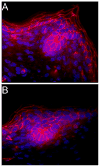An essential role for dermal primary cilia in hair follicle morphogenesis
- PMID: 18987668
- PMCID: PMC2677658
- DOI: 10.1038/jid.2008.279
An essential role for dermal primary cilia in hair follicle morphogenesis
Abstract
The primary cilium is a microtubule-based organelle implicated as an essential component of a number of signaling pathways. It is present on cells throughout the mammalian body; however, its functions in most tissues remain largely unknown. Herein we demonstrate that primary cilia are present on cells in murine skin and hair follicles throughout morphogenesis and during hair follicle cycling in postnatal life. Using the Cre-lox system, we disrupted cilia assembly in the ventral dermis and evaluated the effects on hair follicle development. Mice with disrupted dermal cilia have severe hypotrichosis (lack of hair) in affected areas. Histological analyses reveal that most follicles in the mutants arrest at stage 2 of hair development and have small or absent dermal condensates. This phenotype is reminiscent of that seen in the skin of mice lacking Shh or Gli2. In situ hybridization and quantitative RT-PCR analysis indicates that the hedgehog pathway is downregulated in the dermis of the cilia mutant hair follicles. Thus, these data establish cilia as a critical signaling component required for normal hair morphogenesis and suggest that this organelle is needed on cells in the dermis for reception of signals such as sonic hedgehog.
Conflict of interest statement
The authors state no conflict of interest.
Figures







Comment in
-
The primary cilium: a small yet mighty organelle.J Invest Dermatol. 2009 Feb;129(2):264-5. doi: 10.1038/jid.2008.404. J Invest Dermatol. 2009. PMID: 19148215 Free PMC article. Review.
References
-
- Benzing T, Walz G. Cilium-generated signaling: a cellular GPS? Curr Opin Nephrol Hypertens. 2006;15:245–249. - PubMed
-
- Bonner JC, Osornio-Vargas AR, Badgett A, Brody AR. Differential proliferation of rat lung fibroblasts induced by the platelet-derived growth factor-AA, -AB, and -BB isoforms secreted by rat alveolar macrophages. Am J Respir Cell Mol Biol. 1991;5:539–547. - PubMed
-
- Botchkarev VA, Paus R. Molecular biology of hair morphogenesis: development and cycling. J Exp Zoolog B Mol Dev Evol. 2003;298:164–180. - PubMed
-
- Cano DA, Murcia NS, Pazour GJ, Hebrok M. Orpk mouse model of polycystic kidney disease reveals essential role of primary cilia in pancreatic tissue organization. Development. 2004;131:3457–3467. - PubMed
Publication types
MeSH terms
Substances
Grants and funding
LinkOut - more resources
Full Text Sources
Other Literature Sources
Medical
Molecular Biology Databases

